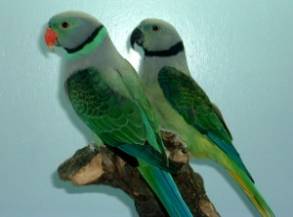
| Back | Blue-winged Parakeet |
Next |
Blue-winged Parakeet is a common bird in the Southern Western Ghats. Tribals of the area keep it as a pet. This parakeet is not an accomplished talker, which is characterized by a harsh, distinct double noted voice (chew… chewee…) uttered chiefly during flight. The body size is 380 mm (about that of the Myna) and the built of the parakeet is slender with a tail that's long and pointed. Both, the male and the female are dimorphic i.e. varied in colour.
The Blue-winged Parakeet is classified thus;
Kingdom – Animalia.
Phylum – Chordata.
Class - Aves (Birds).
Order – Psittaciformes.
Family – Psittacidae (Parrot).
Genus – Psittacula .
Species - columboides .
Local Name - Malayalam - Nilattatta; Hindi - Madangour tota.
Common Name - Blue-winged Parakeet.
For a male,
For a female,

Psittacula columboides Male and Female.
Courtesy: http://home.wanadoo.nl/psittaculaworld/Species/P-columboides.htm
Length of the external organs (in mm):
Adult |
Bill |
Wing |
Tail |
Male |
22 - 25.5 | 142.5 - 156 | 204 - 246 |
Female |
21 – 23 | 135 – 144.5 | 167 |
Distribution – Along the Western Ghats from Khandala down to the south of Travancore including the Nilgiris, Palnis and the Mysore and associated hill ranges.
Habit – Flies straight, Arboreal i.e. lives in trees.
Habitat - Evergreen and semi evergreen forests between the heights of c. 450 to 1050 m.
Food – Wild figs, grains, nectar present on the blossoms of Erythrina, Greville, Salmalia and Butea trees. Flower petals of these plants are also eaten. This frugivorous bird feeds insects to its chicks.
Nesting – Chiefly, between Januarys to March. Nest hole in a tree trunk is between 6 to 30.5 m above the ground. A secondary tree hole, usually a barbet or woodpecker nest is used as its nest site by this parakeet. (Satish Pande, 2003).
Eggs - Female lays 3-5 unmarked white, spherical eggs with an average length of 28.3 mm and width of 24.5 mm.
Parental care – Males and females together contribute to parental care.
Social Organization – Lives, moves, and feeds together in a flock.
| Energy and Wetlands Research Group |
| Centre for Ecological Sciences |
| Indian Institute of Science, Bangalore-12 |
![]()